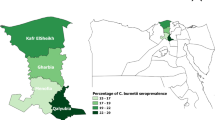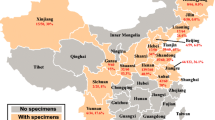Abstract
Serum samples from sand gazelles (n = 227), mountain gazelles (n = 232), and Arabian oryx (n = 96) reared in captivity in Riyadh, Saudi Arabia were tested for the presence of Coxiella burnetii antibodies using an indirect enzyme immunoassay. C. burnetii antibodies were present in 18.3%, 7.3%, and 46.9% of these animals, respectively. The difference in serological prevalence between the three species was statistically significant. Age- and sex-related differences in prevalence were also observed. This study is the first record of C. burnetii antibodies in Arabian gazelles.
Similar content being viewed by others
References
Agger JF, Christoffersen AB, Rattenborg E, Nielsen J, Agerholm S (2010) Prevalence of Coxiella burnetii antibodies in Danish dairy herds. Acta Vet Scand 52:5. doi:10.1186/1751-0147-52-5
Arricau-Bouvery N, Rodolakis A (2005) Is Q fever an emerging or re-emerging zoonosis? Vet Res 36:327–349
Arricau-Bouvery N, Souriau A, Bodier C, Dufour P, Rousset E, Rodolakis A (2005) Effect of vaccination with phase I and phase II Coxiella burnetii vaccines in pregnant goats. Vaccine 23:4392–4402
Banazis MJ, Bestall AS, Reid SA (2009) A survey of Western Australian sheep, cattle and kangaroos to determine the prevalence of Coxiella burnetii. Vet Microbiol 14:337–345. doi:10.1016/J.vetmic.2009
Berri M, Laroucau K, Rodolakis A (2000) The detection of Coxiella burnetii from ovine genital swabs, milk and fecal samples by the use of a single touchdown polymerase chain reaction. Vet Microbiol 72:285–293
Berri M, Souriau A, Crosby M, Crochet D, Lechopier P, Roddlakis A (2001) Relationship between the shedding of Coxiella burnetii, clinical signs and serological responses of 34 sheep. Vet Rec 148:502–505
Bommeli AG (1997) Insitut fur Hygiene und Infektionskrankheiten der Tiere. Justus-Liebig Universitat, Giessen
Byrne WR (1997) Q fever. In: Sidwell FR, Takafuji ET, Franz DR (eds) Medical aspects of chemical and biological warfare. The Borden Institute, Walter Reed Army Medical Center, Washington, p 524
CDC (Center for Disease Control and Prevention) (2010) Q fever in the Netherlands. Available online at: http://wwwnc.cdc.gov/travel/content/in-the-news/q-fever-netherlands.aspx
Çekani M, Papa A, Kota M, Velo E, Berxholi K (2008) Report of a serological study of Coxiella burnetii in domestic animals in Albania. Vet J 173:276–278
Clemente L, Fernandes TL, Barahona MJ, Bernardino R, Botelho A (2008) Confirmation by PCR of Coxiella burnetii infection in animals at a zoo in Lisbon, Portugal. Vet Rec 163:221–222
Ejercito CL, Cai L, Htwe KK, Taki M, Inoshima Y, Kondo T, Kano C, Abe S, Shirota K, Sugimoto T, Yamaguchi T, Fukushi H, Minamoto N, Kinjo T, Isogai T, Hirai K (1993) Serological evidence of Coxiella burnetii in wild animals in Japan. J Wildl Dis 29:481–484
Enright JB, Longhurst W, Franti CE, Wright ME, Dutson VJ, Behymer DE (1969) Some observations on domestic sheep and wildlife relationships in Q-fever. J Wildl Dis 5:276–283
Ferranti MA, Dolan MJ (1993) Q fever meningoencephalitis in a soldier returning from the Persian Gulf war. Clin Infect Dis 16:489–496
Gaukler A, Kraus M (1974) Q-fiever beim Menchen und tieren im zoo Nurmberg. Verh Ber Erkrg Zootiere 16:207–212
Gelpi AP (1966) Q fever in Saudi Arabia. Am J Trop Med Hyg 15:784–798
Greth A, Calves D, Vassart M, Lefévre PC (1992) Serological survey for bovine bacterial and viral pathogens in captive Arabian oryx (Oryx leucoryx Pallas, 1776). Rev sci tech Off Int Epiz 11:1163–1168
Hedrick PW, Parker KM, Gutherrez-Espeleta GA, Rattink A, Lievers K (2000a) Major histocompatibility complex variation in the Arabian oryx. Evolution 54:2145–2151
Hedrick P, Lee RN, Parker KM (2000b) Major histocompatibility complex (MHC) variation in the endangered Mexican wolf and related canids. Heredity 85:617–624
Hernández S, Lyford-Pike V, Alvarez ME, Tomasina S (2007) Q fever outbreak in an experimental wildlife breeding station in Uruguay. Rev Patol Trop 3:129–140
Hussein MF, Alshaikh M, Gad El-Rab MO, Aljumaah RS, Gar Elnabi AR, Abdelbagi MA (2008) Serological prevalence of Q fever and chlamydiosis in camels in Saudi Arabia. J Anim Vet Adv 7:685–688
Karaka M, Akkan HA, Cetin Y, Keles I, Tutuncu M, Ozkan M, Tasal I (2009) Studies on the determination of seroprevalence of Q fever in sheep in the region of Van. J Anim Vet Adv 8:1925–1928
Kazar J (2005) Coxiella burnetii infection. N Y Acad Sci 1063:105–114
Kennerman E, Rousset E, Gölcü E, Dufour P (2008) Seroprevalence of Q fever (coxiellosis) in sheep from the Southern Marmara region, Turkey. Comp Immun Microbiol Infect Dis 33:37–45
Khalili M, Sakhaee E (2009) An update on a serological survey of Q fever in domestic animals in Iran. Am J Trop Med Hyg 80:1031–1032
Laughlin T, Waag D, Williams J, Marrie T (1991) Q fever: from deer to dog to man. The Lancet 337:676–677
Lippe M, Seebastiani A, El-Mutabakani H (1968) Investigation of serum antibodies to rheovirus, adenovirus and C. burnetii in group of inhabitants of Riyadh, Saudi Arabia. Arch Ital Sc Med Trop 49:129–136
Lloyd C, Stidworthy MF, Wernery U (2010) Coxiella burnetii abortion in captive Dama gazelle (Gazella dama) in the United Arab Emirates. J Zoo Wildl Med 41:83–89
López-Olvera JR, Vidal D, Vicente J, Pérez M, Luján A, Gortázar C (2009) Serological survey of selected infectious diseases in mouflon (Ovis aries musimon) from south-central Spain. Eur J Wildl Res 55:75–79
Marrie TJ, Raoult D (2005) Coxiella burnetii (Q fever). In: Mandell GL, Bennett JE, Dolin R (eds) Principles and practice of infectious diseases, 6th edn. Churchill Livingstone, Philadelphia, Pa, pp 2296–2303
Marrie TJ, Embil J, Yates L (1993) Seroepidemiology of Coxiella burnetii among wildlife in Nova Scotia. Am J Trop Med Hyg 49:613–615
Martinov SP, Pandarov S, Popov GV (1989) Seroepizootiology of Q fever in Bulgaria during the past five years. Eur J Epidemiol 5:425–427
Maurin M, Raoult D (1999) Q fever. Clin Microbiol Rev 12:518–553
McQuiston JH, Childs JE (2002) Q fever in humans and animals in the United States. Vector Borne Zoonotic Dis 2:179–191
Mohammed OB, Omer SA, Macasero WV, Kock RA (2010) Serum biochemistry reference range values for Arabian mountain gazelle (Gazella gazella) and Arabian sand gazelle (Gazella subgutturosa marica) at King Khalid Wildlife Research Center Saudi Arabia. Comp Clin Pathol. doi:10.1007/s00580-010-0976-7
Nakoune E, Debaere O, Koumanda-Kotogne F, Selekon B, Samory F, Talarmin A (2004) Serological surveillance of brucellosis and Q fever in cattle in the Central African Republic. Acta Trop 92:147–151
Ostrowski S, Bedin E (2001) Arabian oryx re-introduction in ‘Uruq Bani Mua’arid’, Saudi Arabia: summary and update: January 2001. Re-introd News 20:16–17
Rousset E, Durand B, Berri M, Dufour P, Prigent M, Russo P, Delcroix T, Touratier A, Rodolakis A, Aubert M (2007) Comparative diagnostic potential of three serological tests for abortive Q fever in goat herds. Vet Mircobiol 124:286–297
Rousset E, Berri M, Durand B, Dufour P, Prigent M, Delcroix T, Touratier A, Rodolakis A (2009) Coxiella burnetii shedding routes and antibody response after outbreaks of Q fever-induced abortion in dairy goat herds. Appl Environ Microbiol 75:428–433
Ruiz-Fons F, Rodriguez O, Torina A, Naranjo V, Gortázar C, de la Fuente J (2008) Prevalence of Coxiella burnetii infection in wild and farmed ungulates. Vet Microbiol 126:282–286
Ruiz-Fons F, Astobiza I, Barandika JF, Hurtado A, Atxaerandio R, Juste RA, Barcia-Pérez AL (2010) Seroepidemiological study of Q fever in domestic ruminants in semi-extensive grazing systems. BMC Vet Res 6:1–6
Schalch L, Russo P, De Sa C, Reynaud A, Bommeli W (1998) Combined testing of ruminant serum samples for Chlamydia psittaci and Coxiella burnetii specific antibodies by ELISA. Proceedings from the 6th Congress FeMeSPRum, 14–16 May, Postojna, Slovenia, pp 514–518
Schelling E, Diguimaye C, Daoud S, Nicolet J, Boerlin P, Tanner M, Zinsstag J (2003) Brucellosis and Q-fever seroprevalences of nomadic pastoralists and their livestock in Chad. Prev Vet Med 61:279–293
Schimmer B, Dijkdtra F, Vellema P, Schneerberger PM, Hackert V, Schegget R, Wijkmans C, van Duynhoven Y, van der Hoek W (2009) Sustained intensive transmission of Q fever in the south of the Netherlands, 2009. Eurosurveillance 14:1–3
Schröder HD (1998) The problem of Q fever in zoo ungulates. Berl Munch Tierarztl Wocheneschr 11:173–174
Seyitoĝlu Ş, Özkurt Z, Dinler U, Okomuş B (2006) The seroprevalence of coxiellosis in farmers and cattle in Erzurum district in Turkey. Turk J Vet Anim Sci 30:71–75
Sidewell RW, Lundgren DL, Bushman JB, Thorpe BD (1964) The occurrence of a possible epizootic of Q fever in fauna of the Great Salt Lake desert of Utah. Am J Trop Med Hyg 13:754–762
Simmert J, Heckel O, Rietschel W, Kimmig P, Sting R (1998) Zoonotic aspects of a Coxiella burnetii infection in farmed fallow deer (Dama dama). A case report. Proceedings of the European Association of Zoo and Wildlife Veterinarians, Second scientific meeting, 21–24 May 1998, Chester, UK
Stalis IH, Rideout BA, Sexton P, Oosterhuis JE (1996) Q fever in two species of exotic ruminants. Proc Am Ass Zoo Vet 1996:16–20
Van den Borm R, Vellema P (2009) Q fever outbreaks in small ruminants and people in the Netherlands. Small Rum Res 86:74–79
Yasumuto M, Yanase T, Muramatsu Y, Morita C, Ueno H (1997) Seroepidemiological study of Coxiella burnetii in Cevus Nippon in northern Japan. Jpn J Zoo Wildl Med 2:101–106
Acknowledgements
The authors thank the Secretary General of the Saudi Commission for Wildlife and Dr Robbie Robinson, Director of King Khalid Wildlife Research Center, for their support
Author information
Authors and Affiliations
Corresponding author
Rights and permissions
About this article
Cite this article
Hussein, M.F., Al-Khalifa, I.M., Aljumaah, R.S. et al. Serological prevalence of Coxiella burnetii in captive wild ruminants in Saudi Arabia. Comp Clin Pathol 21, 33–38 (2012). https://doi.org/10.1007/s00580-010-1061-y
Received:
Accepted:
Published:
Issue Date:
DOI: https://doi.org/10.1007/s00580-010-1061-y




